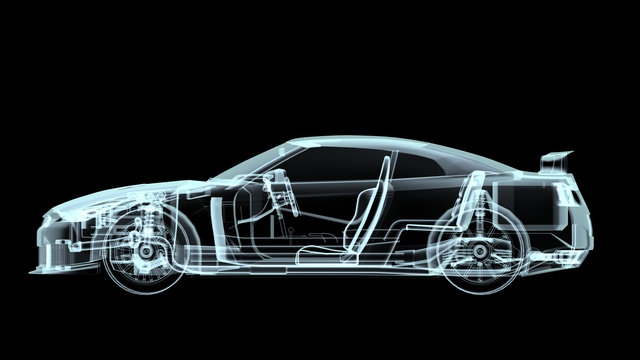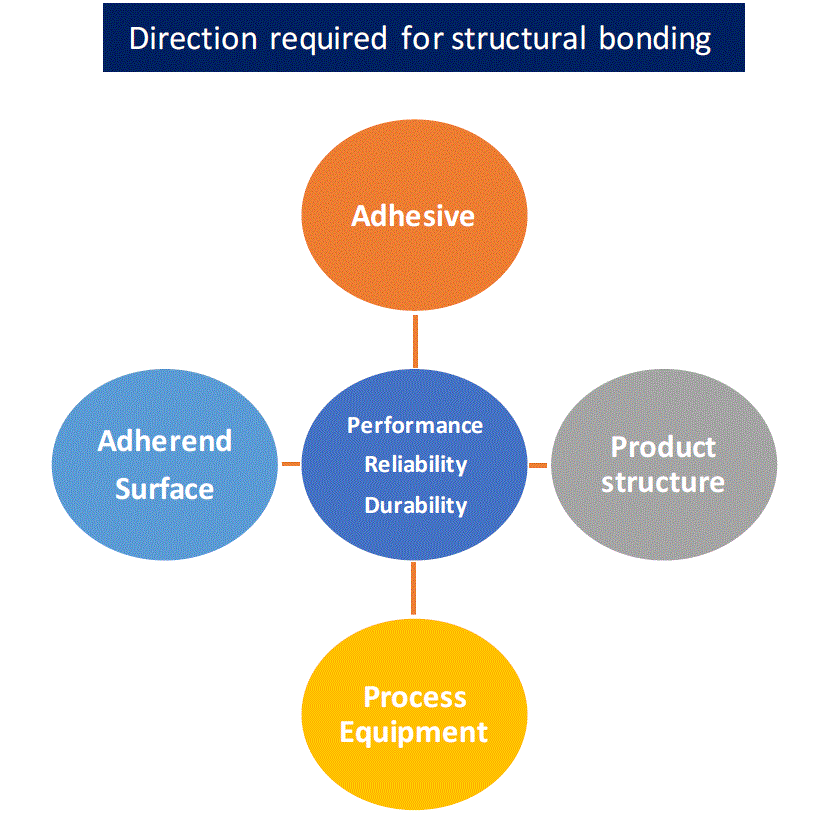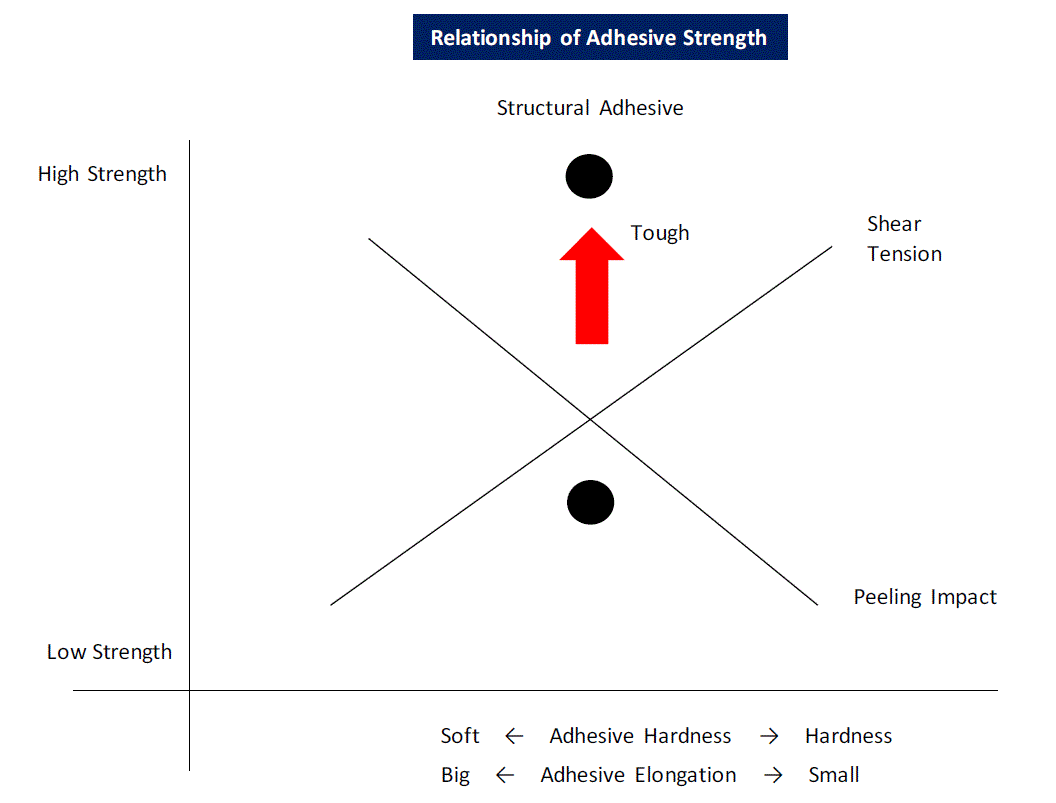Structure Bonding
Automotive Weight Reduction and Bonding Technology
Lightening of the structure of automobiles has attracted attention for fuel efficiency and CO2 reduction.
In recent years, hybrid vehicles (HV) and electric vehicles (EV) have attracted attention. Further, the weight reduction of the vehicle body leads to a reduction in the number of loaded batteries, which is advantageous in terms of cost.In particular,
EV need to be lighter in weight to contribute to an increase in cruising range.Therefore, there are many efforts such as improvement of body materials, adoption of alternative materials, and sophistication of structural design.Under such circumstances, the bonding technology has a great possibility of reducing the structure.For example, rational design is possible by using steel welding and bonding together.There are also new materials other than steel to reduce weight.For example, bonding can be used for joining aluminum alloys, plastics, and composite materials.Furthermore, when these materials are used in a composite form, bonding is a main means because it isnecessary to join different materials.As described above, the future of adhesive bonding as a vehicle body bonding means is extremely large.
Multi-Materialization
 The development of body materials is being developed quite aggressively.In order to achieve high weight reduction, a "multi-material structure" with different materials will be needed.
The development of body materials is being developed quite aggressively.In order to achieve high weight reduction, a "multi-material structure" with different materials will be needed.
Materials for car bodies
1. Steel
High-strength steel sheets have been widely used for automobile bodies. Conventionally, steel sheets with a tensile strength of 370 to 440 MPa have been the mainstream. However, recently, 590 to 980MPa grade steel sheet has been frequently used.In addition, ultra-high-strength steel sheets of 1800MPa class have been realized.
2. Aluminum alloy
European vehicles are increasingly using aluminum alloys. For this purpose, drawn materials, cast materials and plate materials are used. As the type of aluminum alloy, 6000 series and 5000 series are used. Recently, the 7000 series (Al-Zn-Mg) has begun to be used in aircraft and the like.
3. Galvanized steel sheet
Conventionally, hot-dip galvanized steel sheets (GI materials) and alloyed galvanized steel sheets (GA materials) have been used. Recently, galvanized steel sheets that
can prevent electrolytic corrosion due to contact between steel and aluminum have been used.This has already been used in home appliances and building materials.
4. Other metals
Magnesium alloy, which has the lowest specific gravity of 1.8 among practical metals, and has high specific strength and specific rigidity, is expected as a next-generation structural material.
5. Composite material
Since the composite material is a lightweight and high-strength material, it is widely used in housing equipment such as bath taps, sports fields such as fishing rods and golf club shafts, small boats, aircraft, artificial satellites, and various vehicles.The composite material used in automotive bodies is fiber reinforced resin (FRP), which uses resin as the fiber and matrix material.
The composite of glass fiber and resin is glass fiber reinforced plastic (GFRP). The composite of carbon fiber and resin is carbon fiber reinforced plastics (CFRP).
As the fibers, long fibers or short fibers cut short (cut fibers) are used.Conventionally, a thermosetting resin such as an epoxy resin, a polyester resin, a phenol resin, or a polyimide resin has been mainly used, but recently, a thermoplastic resin such as polyethylene, polypropylene, polyamide, or polycarbonate has been used.
A fiber reinforced resin using a thermoplastic resin is called FRTP (Fiber Reinforced Thermo Plastics).
In the future, CFRTP, which is a composite material of carbon fiber and thermoplastic resin such as polypropylene or polyamide (nylon), is trending.
6. plastic
Plastic is used for interior materials and bumpers in automobiles. In the future, polycarbonate resin will be used as the window material instead of glass, which accounts for a large proportion of the body weight.
Performance Required for Structural Adhesives

The following can be expected from adhesive bonding in vehicle body assembly.
1. Toughness
It is important for the adhesive to achieve both impact resistance at low temperatures and adhesive strength at high temperatures.But these two properties are contradictory. It is not appropriate for the low-temperature impact properties that the elastic modulus of the adhesive is too high.
The adhesive must have an elongation property that can follow the deformation of the part.Since the adhesive is a viscoelastic body, when a load is applied at a high speed, the viscous property becomes small and the elastic property becomes large.
Therefore, it is necessary to optimize the physical properties in consideration of the speed dependency of the adhesive.
That is, a two-component system having two tan δ at low temperature and high temperature, or a hard resin and a soft elastomer have a molecular gradient or a sea-island structure.By adopting such a structure, it is conceivable to improve low-temperature impact characteristics.
2. Adhesive hardness, elongation
With general adhesives, hard ones have low elongation and soft ones have high elongation.If the adhesive is hard and has low elongation, the shear strength and the tensile strength increase, and the peel strength and the impact strength decrease.
The opposite is true if the adhesive is soft and stretches significantly.
In order to increase the peel strength, the adhesive needs to be stretched.
Further, in order to increase the impact strength, it is necessary to have flexibility to absorb impact energy.Adhesives that are strong against various forces are preferably neither too hard nor too soft.A high-strength adhesive called a structural adhesive has both hardness and elongation, and has a tough property.
Modifications such as adding a hard epoxy and a soft rubber component to the acrylic resin have been made to achieve toughness.Very strong properties can be obtained by forming structures such as our molecular gradient structure, sea-island structure, and polymer alloy.
3. Tensile strength and adhesive strength
Tensile shear strength and tensile strength vary with the speed of applied force When a force is applied at a high speed, the breaking strength is higher than when a force is applied at a low speed.
4. Evaluation characteristics
Compatibility with adherends, high and low temperature strength, shock absorption, outdoor exposure durability, moisture resistance, heat deterioration resistance, heat cycle resistance, creep properties
5. Surface modification
Ideally, the surface of the adherend has excellent adhesion. However, many of them are actually inferior in adhesiveness. It is necessary to improve the adhesiveness of the surface by modifying the surface of the hard-to-bond material. Surface modification is the basis for ensuring adhesion reliability.There are various types of surface modification methods such as plasma irradiation, short-wavelength ultraviolet irradiation, flame treatment, and laser irradiation.
There is also a method of forming fine irregularities to give an anchor effect to the surface of resin or metal. Plating, etching and laser abrasion have also been developed.
In addition to surface modification by equipment, there is also a method of modifying the surface with a primer or a coating agent. It is also conceivable to laminate and
form a film having excellent adhesion.

Contact
We appreciate your interest in KGK Chemical Corporation. Please contact us from the bellow and complete the requested information.
-
Business Hours Mon.-Fri. 8:30am – 5:30pm Japan time zone
- REQUEST A QUOTE
